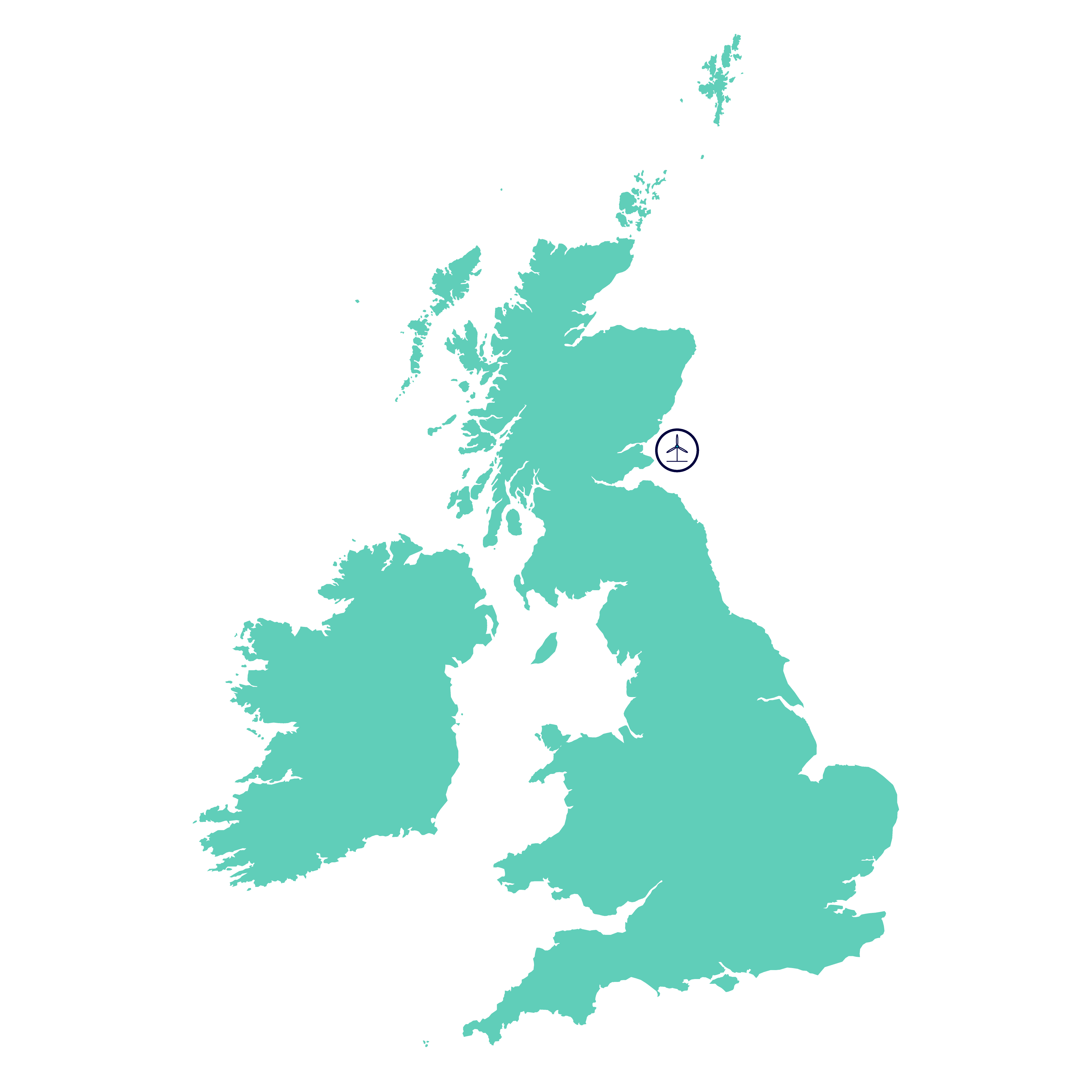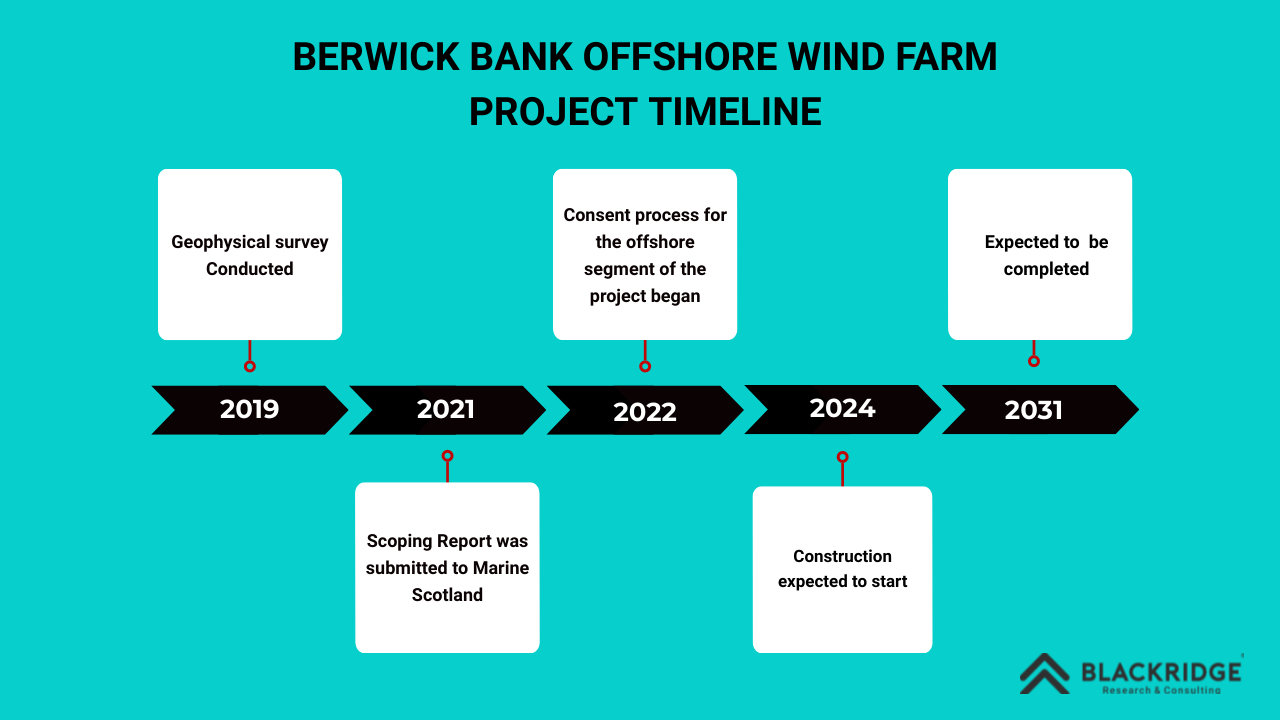Table of Contents
| Project at a Glance | |
| Project Name | Berwick Bank Offshore Wind Farm |
| Project Type | Greenfield |
| Project Location | Off the East Lothian coast, Scotland |
| Sector | Energy |
| Subsector | Wind Energy |
| Project Value | USD 5 Billion |
| Project Status | Construction expected this year (2024) |
| Project Developer/Coordinator | SSE Renewables |
| Capacity | 4.1 GW |
| Construction Start Date | 2024 (expected) |
| Project Completion Date | 2031 (expected) |
Overview
The Berwick Bank Offshore Wind Farm is one of the largest wind farms. This greenfield project is located off the East Lothian coast in Scotland, with an installed capacity of 4.1 GW. Developed by SSE Renewables, this USD 5 billion project is anticipated to commence construction in late 2024 and be completed by 2031. Positioned in the North Sea, the offshore wind farm is designed to generate enough renewable energy to power over six million homes, doubling the energy needs of all Scottish households. Having reached an advanced stage of development, Berwick Bank will significantly boost Scotland's renewable energy capacity by nearly 30%.
Project Background
The Berwick Bank Wind Farm, situated within the southeastern extent of the former Firth of Forth Zone, represents a major development in the UK's renewable energy. Initially comprising two separate proposals—Berwick Bank Wind Farm and Marr Bank Wind Farm—the project was consolidated into a single entity with a power generation capacity of up to 4.1 GW following initial rounds of public consultation.
A geophysical survey conducted in 2019 across the Proposed Development Array Area gathered crucial geophysical and bathymetric data, setting the stage for subsequent development phases. By November 2020, the project was introduced to the public through a virtual exhibition, marking a significant step in engaging local communities and stakeholders. One of the world's most extensive ornithology surveys was completed over the proposed area, involving 25 months of aerial surveys within a 16 km buffer zone.
Find Offshore Wind Project and Tender Leads in UKClaim Your Free Leads!
The Berwick Bank Wind Farm project is currently in the consent application stage, with submissions made to East Lothian Council and Marine Scotland, including a comprehensive Environmental Impact Assessment (EIA). Following the decision to merge the proposals, an updated Scoping Report was submitted to Marine Scotland in October 2021. The consent process for the offshore segment began in December 2022, with the onshore elements following in March 2023.
In March 2023, the project promoted a Compulsory Purchase Order (CPO) to secure necessary land rights for onshore infrastructure. A final decision from the authorities is anticipated in late 2023. The project benefits from a 50-year Agreement for Lease (AfL) with Crown Estate Scotland, ensuring long-term viability and leveraging advancements in technology, operations, and maintenance, allowing the wind farm to operate beyond the initial 25-year period.
Project Location Map

Berwick offshore wind farm is located in the North Sea, in the outer Firth of Forth, Scotland.
Technical Specifications
The Berwick Bank Wind Farm encompasses up to 307 wind turbines across a proposed development area of approximately 1,314 km². Positioned about 37.8 km east of the Scottish Borders coastline and 47.6 km east of the East Lothian coastline, the turbines will be situated in waters with an average seabed depth of 51 meters below the Lowest Astronomical Tide (LAT).
The turbines will be mounted on either suction caisson jacket or piled jacket foundations, each featuring a tower section, nacelle, and three rotor blades with a maximum diameter of 310 meters. The blade tip heights will range from a minimum of 37 meters to 355 meters above LAT. The infrastructure will include up to ten Offshore Substation Platforms (OSPs) with piled jackets for their foundations, interlinked by subsea inter-array cables.
The Berwick Bank project will connect to the UK electricity grid at Branxton in East Lothian and Blyth in Northumberland for power transmission. Offshore export cables will transport electricity from the OSPs to landfall points, linking to the grid at a new 400 kV substation near Torness Power Station.
The project benefits from three Grid Connection Offers from the National Grid Electricity System Operator (NGESO) for a total of 4.1GW of Transmission Entry Capacity, including the recently secured "Cambois connection" signed in June 2022. Designed for a lifespan of 35 years, the wind farm's extensive interconnection network and robust infrastructure ensure a reliable and efficient supply of renewable energy to the national grid.
Contractors Involved
| Contractor | Awarded Date | Service Provided |
| UTEC (Acteon) | Not specified | Topographical and ground-penetrating radar surveys for cable landfall areas |
| RPS | July 2020 | Lead offshore Environmental Impact Assessment (EIA) and shadow Habitat Regulation Appraisal (HRA) consultant |
| RPS | July 2020 (work scope) | Develop Scoping Reports, EIA Reports, HRA Screening Reports, and Reports to Inform Appropriate Assessments (RIAAs) |
| ITPEnergised | Not specified | Develop onshore scoping report (submitted August 2020) |
| British Geological Survey (BGS) & Cathie | October 2020 | Develop a ground model for front-end engineering design (FEED) |
| Hi Def Aerial Surveying & SSE Renewables | June 2021 | Conduct 24-month aerial survey program |
| Kent | April 2023 | Complete FEED and Detailed Design of WTG foundations and substructures (initially concept design) |
| BVG Associates (BVGA) | Not specified | Conduct an economic impact study |
Project Benefits
The Berwick Bank Wind Farm is set to add an cost of GBP 8.3 billion to the UK economy over its lifetime. The offshore wind farm is expected to generate substantial economic and employment benefits, including 6,000 Full Time Employment (FTE) years during its development and 4,800 FTE job years annually during the construction phase across Scotland. Once operational, the wind farm will support approximately 750 jobs annually, contributing to 26,100 total FTE years in Scotland through direct, indirect, and induced employment.
The project is set to generate GBP 360 million GVA per annum during manufacturing, construction, and installation, equating to 80% of Scotland's 2019 offshore wind sector GVA. Aligning with Scottish planning and energy policies, Berwick Bank Wind Farm maximizes the generation capacity of a resource-rich area, benefiting GB consumers and the wind industry at large.
Project Timeline

Project cost
The estimated project cost of the Berwick offshore wind farm is USD 5 Billion.
Environment Benefits
Berwick Bank Wind Farm will effortlessly advance decarbonization efforts by providing enough low-carbon electricity to power over 5 million homes annually starting as early as 2026. This project is crucial in closing the gap towards the Scottish Government's offshore wind deployment target of 11GW by 2030. It will contribute to climate change emission reduction targets through the 2020s and into the early 2030s. Over its lifecycle, Berwick Bank will prevent 9,178,312 tonnes of CO2 equivalent from being emitted compared to conventional fossil fuel energy generation, with net savings of 2,951,519 tonnes of CO2 equivalent when accounting for construction phase emissions.
Current Status & Future Outlook
The construction activities for the Berwick Bank Wind Farm are expected to begin in 2024 and span up to 96 months. Following the operational phase, the decommissioning process will mirror the construction timeline, proceeding in reverse. The operation and maintenance strategy, to be finalized once the baseline location and technical specifications are determined, will incorporate preventative and corrective measures.
This strategy will feature an onshore operation and maintenance base, likely at a harbor. It will be supported by a logistics framework utilizing a Service Operation Vehicle (SOV) and Crew Transfer Vessel (CTV). As the project advances, this approach ensures efficient and reliable operation and upkeep of the wind farm, securing its long-term contribution to renewable energy production and climate goals.
Latest Update: Northumberland County Council has granted outline planning permission for the Berwick Bank offshore wind project’s onshore export cables, converter station, and associated grid connections for the Cambois connection point. The offshore grid connection point will be near Blyth, Northumberland.
Conclusion
The Berwick Bank Offshore Wind Farm represents an advancement in Scotland's renewable energy market. With its ambitious 4.1 GW capacity and USD 5 billion investment, the project is one of the largest globally. It will power over 5 million homes annually by 2026. Developed by SSE Renewables, it supports economic growth and job creation, meets Scotland's renewable energy targets, and reduces carbon emissions. As construction commences in 2024, followed by a decade-long operational phase and decommissioning plan, Berwick Bank is set to exemplify sustainable energy development, contributing to a cleaner and greener future for future generations.
Connect with decision-makers of offshore wind projects in the UK for business opportunities.
Subscribe to our UK Offshore Wind Farm Project and Tender Database to access reliable and high-quality insights on upcoming, in-progress, and completed offshore plant projects across the world or in your desired geographical location.
Our user-friendly platform provides essential details, timely updates, key stakeholder contact information, and business opportunities tailored for engineering companies, industry professionals, investors, and government agencies.
Start a free demo to take your business to the next level!







Leave a Comment
We love hearing from our readers and value your feedback. If you have any questions or comments about our content, feel free to leave a comment below.
We read every comment and do our best to respond to them all.